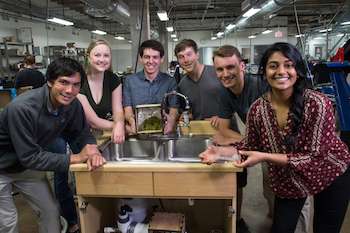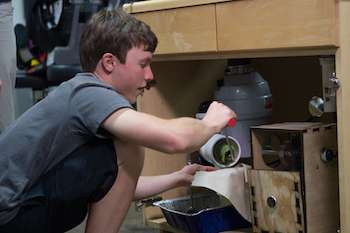Waste not, grow more food: Engineering students' device makes composting easier

It's good for crops, it's good for water and, in the end, it's good for people and the planet. Why would anyone not turn food waste into compost?
Rice University engineering students asked that question at the start of the school year and have spent the months since refining their answer.
The team known as (com)post-haste invented a device that sits under one's sink and takes macerated food waste produced by a standard garbage disposal and sends it in one direction while liquid waste (including water) goes in another. Effectively, it simplifies the process of recycling garbage into a useful product while helping to protect water supplies.
The students make up one of more than 80 capstone design teams at Rice. Most senior engineering students are required to complete a project to graduate and are presented with a host of possibilities when they begin their classes in August.
For all the members of (com)post-haste, developing the device they call The BioBlend was a natural.
"I think for all of us this was the top choice," said Kavana Gowda, who like all of her teammates is a senior mechanical engineering student. Other members are Christina Petlowany, Andrew Miller, Edgar Silva, Mitch Torczon and Ryan Yeh.
The students have spent much of the last eight months working in the basement of Rice's Oshman Engineering Design Kitchen, where they have installed an actual research kitchen – or at least the sink part.
The project is a partnership with NASA, which has an interest in such devices for outposts on the moon, Mars and beyond, and Chalmers University of Technology in Sweden, which pitched Rice on the project and intends to install The BioBlend at its Living Lab, where it will be tested alongside other emerging household technologies. Rice lecturer Matthew Elliott is the team's faculty adviser.
"I think one of the major barriers to being eco-friendly in a variety of ways in the United States is people aren't willing to put in any effort," said Torczon of the device. "This doesn't require users to change their behaviors. They can continue putting food down the garbage disposal, and once every couple of days take it out, just like taking out their trash."
The difference is The BioBlend produces a moist, finely chopped form of waste that takes less time to turn to compost than regular garbage. Alternately, it can be used to generate biogas.

"One of the things our sponsors want to see is if they can make the device large enough to put in the basement of an apartment complex or a grocery store or restaurant, places with a ton of food waste," Torczon said. "They could create a lot of biogas they could then turn around and sell or, if they're in a restaurant, use themselves."
"I think a family of four, using a biogas generator with their waste, would be able to make enough for them to cook with," Gowda added.
Whether it's used for compost or biogas production, the key to The BioBlend's success will be its ability to keep garbage out of wastewater treatment plants, where it's not only useless but also costly and complicated to remove.
The team's research into separation techniques spanned sewage plants to hand-cranked tabletop devices for making jellies and tomato sauce. What they had in common was a circular strainer with a large screw in the middle that pushes solid waste along while allowing liquid to escape. Their own motor-driven, spring-loaded version has a failsafe to keep unwanted solids like ice from jamming the system.
A weight sensor tracks how full the bin is, a cutoff switch automatically trips before it overflows and a carbon filter helps quash odors and keep flies away from the compost.
The team has not ruled out giving The BioBlend Wi-Fi powers to alert users to its status via the Internet, Torczon said. They could just make it beep when full, but the students are wary that annoyed users would simply disconnect it rather than keep with the program.
The teammates had no problem finding a way to feed their creation. "One of the cool things about the project was digging once a week through the trash in the Rice serveries," Yeh said.
"It's caused me to reevaluate how much food I'm throwing away," Torczon added. "Our sponsors said at the beginning they hoped it influenced our behavior."


















